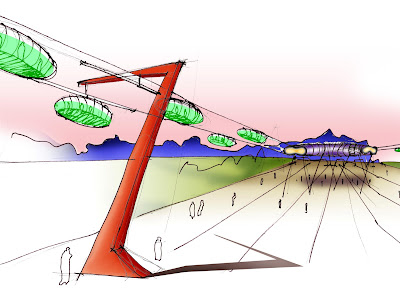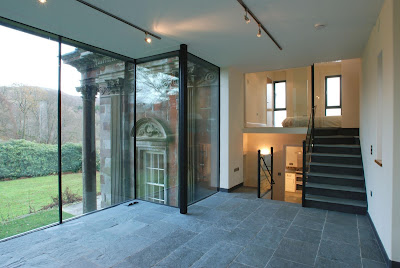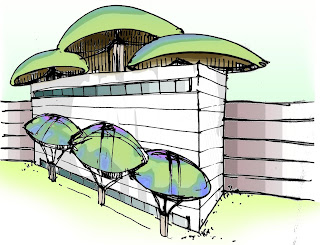IDBE Cohort 15 starts …
September 2008 saw the arrival of the fifteenth cohort of IDBE students. Twenty-four joined the course (another record – for quantity anyway ...) Job descriptions are not straightforward, but in round terms we have seven architects, six engineers, three project managers, three landscape designers, and others from town planning, construction management, design management; and straight management. The majority are UK based, but we also have students from Greece, Nigeria, USA, Canada, Hong Kong, South Korea, Egypt and Columbia (South America).
September week studio project
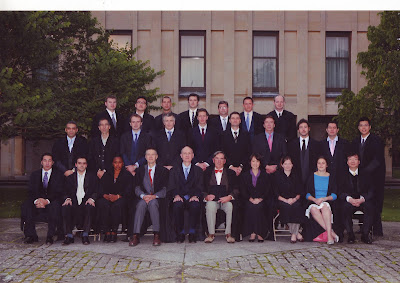 |
Cohort 15 get the full Cambridge experience … |
The studio project was for the design of a generic cladding system to suit 1960s office buildings. Working in interdisciplinary teams, the students designed the cladding and made 1:20 scale models to test their proposals in the artificial sky and on the heliodon. Most of the teaching took place in the Department of Engineering but the artificial sky has been completely re-built in the basement of the Department of Architecture where we also used the new workshop. Dr Nick Baker led the studio project and was assisted by Dr Mauro Overend. Dr Torwong Chenvidyakarn also assisted.
Schemes varied widely. One team suggested dividing the facade of each office into a 3x3 grid with pivoting baffles in each grid-square that could be adjusted by occupants according to external conditions and internal needs.
Another team decided to use a translucent wall that contained some sections given over to transparent panels. The transparent panels would not necessarily be in the same location for every office so offering a variegated façade (below).
Light shelves were evaluated, with one team experimenting with both these and with borrowed light from adjoining offices. The image below shows daylight graphs from various options superimposed onto the sectional drawing.
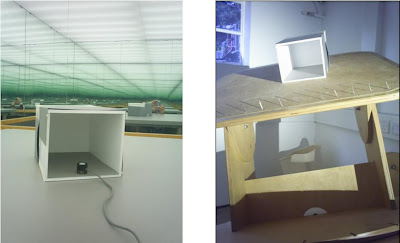 |
Artificial sky (left) and heliodon (right) |
Schemes varied widely. One team suggested dividing the facade of each office into a 3x3 grid with pivoting baffles in each grid-square that could be adjusted by occupants according to external conditions and internal needs.
 |
Team Ogee's pivoting baffles |
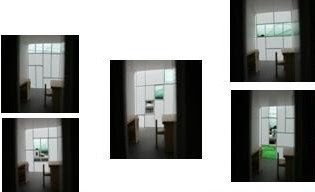 |
Transclucent wall with some transparent panels |
Measurements taken in the various physical models were compared with calculations using numerical methods.
Constructing carefully scaled dolls house furniture out of balsa wood was also indulged in by most of the teams, and there was competition to make the best 1:20 house plant.
Where are they now?
Profile: Marga Jann
French-American architect, Marga Jann (IDBE 10), is an adjunct associate professor in the D.Arch. programme of the University of Hawai’i at Manoa and a visiting professor to Duksung University, Seoul, Korea. In Seoul her studio design work includes live projects for the U.S. Embassy and Seoul Museum of History, as well as an eco-friendly village on the island of Batiki, Fiji with both U.H. and Duksung students.
Two of Marga’s IDBE papers, Non-Governmental Projects in Latin America and Sacred Architecture in the Contemporary World have been presented at professional conferences in Hawaii (2008 Hawaii International Conference on Arts and Humanities) and Michigan (Theology and the Built Environment Colloquium, Calvin College, MI / U. Otago, New Zealand) respectively.
Marga’s interdisciplinary collaborative design firm, Poetic License (www.PoeticLicenseIntl.com), runs live projects in academia to encourage sustainable social entrepreneurship, providing hands-on internship opportunities for aspiring young design professionals as a kind of ‘in-house’ university incubator initiative. One such project is a large tsunami village for Indian widows in South India (www.StudioImpact06.com) for NGO Acts of Mercy, undertaken while associate professor at Judson University outside Chicago. Other ‘live project’ endeavours include children’s homes in Mexico and Guatemala while studio critic at Stanford University, California, a Protestant museum/community centre in Paris while lecturing at L’Ecole Nationale des Ponts et Chaussées, and tsunami/disaster relief housing while a Fulbright professor to Sri Lanka (2005-2006).
 |
Acts of Mercy Widows’ Tsunami Village, Chennai |
Marga’s awards include numerous French competition winners as a young architect in Paris, AIA design recognition (e.g. Parole de Foi Children’s Home in Pune, India), grants including two Stanford University Haas Center for Public Service Fellowships, a French Embassy Award, and two Stanford Institute of International Studies Hewlett-Packard Awards. Marga is a fellow of the Cambridge European Society and her work has been published in numerous art and architecture magazines and newspapers (e.g. Hawaii Architecture & Interiors, Licensed Architect, Korea Times, A+U).
Marga says the IDBE course obliged her to write and helped her to grow as a designer, to stay current with new technologies, and to rethink issues of sustainability while meeting professional development course criteria for various international professional bodies. Additionally she has found that the networking provided - contact with colleagues from around the world including access to the vast potential client pool of Cambridge alumni, staff and professors - has been invaluable: Marga co-taught with IDBE colleague Eeshani Mahesan at the Colombo School of Architecture in Sri Lanka and former classmate and colleague Jason Pomeroy visited her U. Hawai’i graduate studio as visiting critic. In Seoul she is working with alumnus Tariq Hussain of Maxmakers, a Swiss real estate advisory firm.
Matt Cousins (IDBE 10) has just published a book which draws heavily on his IDBE thesis. Design Quality in New Housing: learning from the Netherlands is published by Taylor & Frances in October 2008, and is available in paperback and hardback. Case studies from both UK and the Netherlands are presented and analysed, together with the housing policies and construction practices of the two countries.
Graeme Gidney (IDBE 12) an Associate Director at Buro Happold, has just published a detailed article entitled ‘Building design links to infection control’ in Health Estate, the journal of the Institute of Healthcare Engineering and Estate Management (volume 62, number 8, pages 41-46).
Matt Cousins (IDBE 10) has just published a book which draws heavily on his IDBE thesis. Design Quality in New Housing: learning from the Netherlands is published by Taylor & Frances in October 2008, and is available in paperback and hardback. Case studies from both UK and the Netherlands are presented and analysed, together with the housing policies and construction practices of the two countries.
 |
| Design Quality in New Housing by Matt Cousins |
Drawing on his IDBE thesis which was examined earlier this year and received one of the highest marks awarded for an IDBE thesis, the article reviews the extent to which a hospital’s built environment, clinical and ward layout, as well as the clinical procedures adopted, are directly linked to hospital acquired infection rates.

